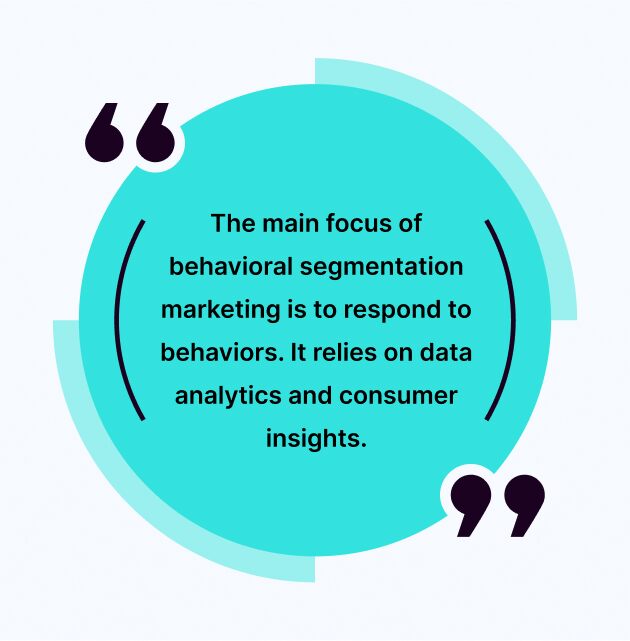REVE Chat Version 4.0
Version 4.0
Upgrade your website to an IM platform & beyond
Blending the strengths of IM and Live Chat
Upgrade your website to an instant messaging platform and beyond


Understanding customers inside out is key to serving their needs effectively. Maybe that’s why segmentation has long been vital to effective marketing strategies. When customers are divided into smaller groups based on their actions and needs, it puts businesses in a good position to solve their problems and achieve more ROI on their marketing or sales efforts.
While demographic data is often the first step in understanding and addressing customer’s needs better, it’s not always enough. Sometimes a business needs more information about customers. This is where behavioral segmentation helps.
This kind of segmentation is vital for identifying the behavior of your target audience, or essential for the knowledge of how they interact with your business. The real purpose of using behavioral segmentation is to match customer’s behavior patterns with appropriate messaging.
It’s much more than just recognizing that people have different habits. The key goal is to optimize marketing campaigns in a way that matches those behaviors.
In this blog, we will explore behavioral segmentation in detail, and understand its definition, types, characteristics, benefits, and strategies.
But before moving further, let’s first get started with understanding the definition of behavioral segmentation…
Behavioral segmentation is a marketing process of dividing customers into segments based on their unique behavior patterns when engaging with a business, website, or any other aspect of a brand.
In this type of segmentation, customers are often grouped based on different aspects or their different habits, including –
It’s obvious that behavioral segmentation goes beyond demographic and geographic data and rather has a sole focus on leveraging behavioral patterns and data. This kind of segmentation provides businesses with a complete understanding of their audience.
Behavioral segmentation is a useful marketing tool as it categorizes consumers based on the kind of attitude, usage pattern, and buying behavior they show toward a brand. Marketers can leverage this segmentation to convey messages more effectively and drive conversion rates.
Here are the reasons why behavioral segmentation is important –
The purpose of behavioral segmentation is to categorize consumers based on their diverse behavior such as product usage, loyalty to the brand, and purchasing patterns. These segments give deep insights into customer behavior and form the basis of targeted marketing.
There are 4 types of behavioral segmentation, including –
This type of segmentation is done with a focus on analyzing the varying patterns and trends that customers show when making a purchase decision. It involves insights into the buying stage of the customer, the problems they are facing at each stage, and the incentives they are likely to respond to at each stage.
When a business segments customers based on purchase and usage behavior, it understands different behaviors and the types of campaigns that might suit their varying needs.
The information gathered from this type of segmentation can help a business respond to customer needs in an effective and relevant manner.
This type of segmentation is essential for categorizing customers based on their likelihood of purchasing products or services at specific times or occasions.
Occasions could include festivals holiday seasons, or special days such as a wedding, birthday, etc.
When segmentation is occasion-based, the main target for a business is to monitor a customer’s purchasing behavior to identify and establish a pattern. This pattern-related information or data can be used to market the customers in advance.
When customers make purchases, they consider value. They buy products or services based on the benefits to be had. Sometimes, the same product could be viewed differently by customers based on the perceived value or benefits they may get,
For example, a smartphone can be purchased for the high storage space it offers, or for the kind of camera quality it possesses. So, the same product may help you group customers on data by benefits.
This is how businesses can easily understand what features drive purchases, and what needs to be worked upon more. With benefits-based segmentation, you can gain information about the key qualities of your product and features where you need to put more effort into improvement.
Loyal customers are like gold specks of dust. They help generate repeat purchases and revenue for the business. It’s their actions that bring referrals and word-of-mouth benefits. That’s why businesses should do loyalty-based segmentation to the behavior patterns of their loyal customers and understand their needs better.
With this type of segmentation, a business can better understand the key behaviors that nurture loyalty and zero in on the audience that is most likely to respond to loyalty programs. Similarly, categorizing customers based on loyalty can also give information on the key factors for keeping customers happy and maximizing their loyalty.
The main focus of behavioral segmentation marketing is to respond to behaviors. This is done to craft and launch targeted campaigns and messaging. Unlike other forms of marketing, here the goal is to devise strategies that resonate with specific behaviors and preferences.

Here are the key characteristics of behavioral segmentation marketing –
Relying only on demographic data comes with certain limitations. It does not give information about consumer behavior. So, a business fails to devise relevant messages and is unable to cater to the specific needs of its customers. However, a business that segments can convert 80% of customers.
Let’s look at behavioral segmentation benefits for businesses –
For a business, it’s always a big challenge to effectively engage customers in different behavioral segments. They often lack the data and analysis required to develop a more nuanced understanding of their audience. This often dilutes their marketing efforts.
Here are discussed some of the key behavioral segmentation strategies –
Data is always important when it comes to knowing about customers in detail and understanding their tastes and preferences. So, a business should focus on collecting information through surveys, past data analysis, social media monitoring, and web analytics.
Creating detailed buyer personas is another key strategy of behavioral segmentation. The goal is to create elaborate personas representing different segments within your target audience. Once the profiling is done, you must identify key behavioral variables aligning with your special goals.
Tech integration is vital for consolidating customer data and tracking interactions across touchpoints. Using CRM systems and implementing marketing automation tools are essential steps in customer data consolidation. These tools can help you respond to customer behaviors in real time and offer them tailored messages.
Testing your marketing strategies is vital to understand which one fits the needs perfectly. When different versions of messages, campaigns, and offers are tested, they give deep insight into different behavioral segments.
A business needs to tailor content to different segments for effective targeting. The goal should be to customize content ( in ads, emails, and websites) based on the specific behaviors of customer segments. This can always contribute to effective messaging.
Loyal customers bring huge value and that’s why every business must reward customers for loyalty. The focus should be on rewarding customers for specific behaviors, such as for including referrals or for making frequent or repeat purchases. So, your loyalty programs should be driven by behavior.
When you have historical data on customers, you can always anticipate future behavior and align your marketing strategies to that. Using predictive models is very helpful in anticipating future trends or behaviors that customers are expected to show.
A business can encourage customers to share feedback and often deliver a better overall experience than others. After all, feedback is invaluable in gaining insights into the kind of experiences customers have, or the kind of attitudes they nurture about a brand. So, you should always consider feedback analysis to stay one step ahead of customer needs.
E-commerce giant Amazon is a great example of behavioral segmentation. It uses customer’s browsing behavior and purchase history data to offer personalized recommendations. They suggest relevant products based on the analysis of past purchases, and items viewed or added to the cart. This kind of recommendation greatly improves the overall shopping experience for customers.
Netflix is another solid example of behavioral segmentation as the company constantly reinvents its shows and content based on the viewing behavior of audiences. Its search algorithms continuously analyze the types of content users watch, the genres they prefer most, the actors they like the most, etc. That’s why it has been able to tailor content to individual preferences and boost engagement levels.
Fitbit is a good example of achieving success by leveraging behavioral segmentation to great effect. It tracks users’ physical activity levels with the view to setting specific or personalized goals. The device also gives real-time feedback and offers rewards in cases customers achieve certain milestones.
Have you ever wondered how Airbnb has been so successful in suggesting properties that perfectly align with user’s interests? Well, it leverages past user data with great effect. It uses user preferences data on locations and accommodation to personalize recommendations.
Marketing becomes more effective when you have data and information on customer behavior. You are then aware of what they like and what not. This is the very basis of personalized offers and experiences to them at each stage of the customer journey.
At REVE Chat, we understand the huge value of behavioral segmentation to enhance the impact and returns of your marketing ROI. We have a variety of engagement tools that your business can use to better understand customers and their preferences.
Your business can use our AI-powered chatbot to automate interactions with customers and get useful information and data. We also have video chat software, co-browsing software, a ticketing system, and live chat software to help you engage better with your audience.
With us, you can sign up and check a wide range of tools for improved engagement and customer analytics.
Start a 14-day free trial, no credit card required
Stay updated with the latest trends and ideas we share
What happens when your business doesn’t have a well-defined lead management process in place? You might then struggle to track,...
In your business, you need information about your customers’ pain points, preferences, requirements, and most importantly their feedback. Now think this...
How does the future look like to you with Artificial Intelligence shaping most of our day-to-day tasks? Sometimes it feels...


